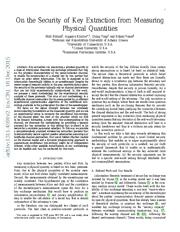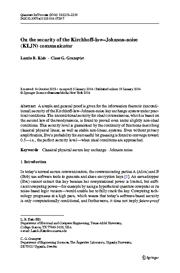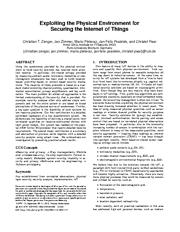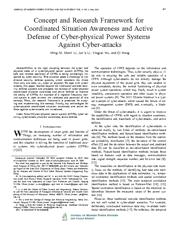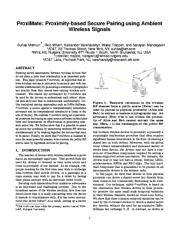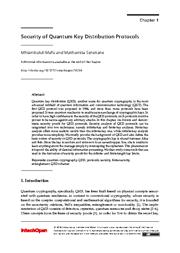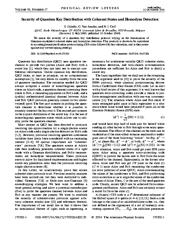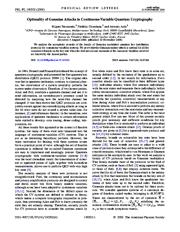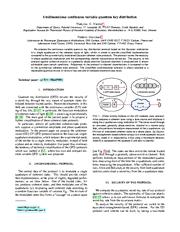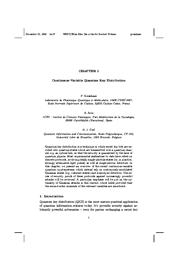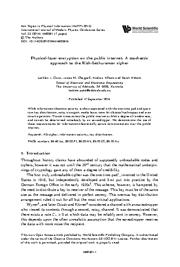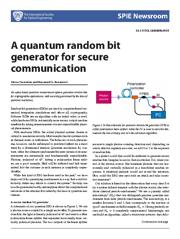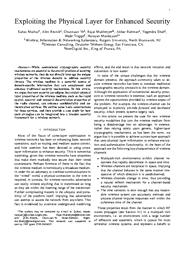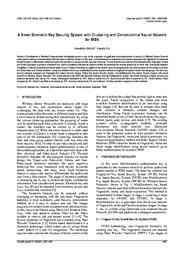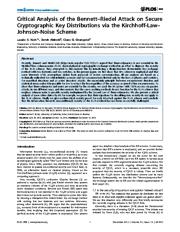A copy of this work was available on the public web and has been preserved in the Wayback Machine. The capture dates from 2019; you can also visit the original URL.
The file type is application/pdf.
Filters
On the Security of Key Extraction from Measuring Physical Quantities
[article]
2015
arXiv
pre-print
Key extraction via measuring a physical quantity is a class of information theoretic key exchange protocols that rely on the physical characteristics of the communication channel to enable the computation ...
We focus on the signal strength between two wirelessly communicating transceivers as the measured quantity and we use an experimental setup to compute the conditional min-entropy of the channel given the ...
BACKGROUND OF KEY EXTRACTION FROM MEASURING PHYSICAL QUANTITIES
A. ...
arXiv:1311.4591v2
fatcat:fhhsfv22sffevotzk3cponguaa
On the security of the Kirchhoff-law–Johnson-noise (KLJN) communicator
2014
Quantum Information Processing
The unconditional security for ideal circumstances, which is based on the Second Law of Thermodynamics, is found to prevail even under slightly non-ideal conditions. ...
This security level is guaranteed by the continuity of functions describing classical physical linear, as well as stable non-linear, systems. ...
In order to assess the security of the shared key, one must compare the probability distribution of successfully guessing each possible key sequence of the N -bit-long key extracted by Eve, encompassing ...
doi:10.1007/s11128-014-0729-7
fatcat:keik24fh5rcltl2f32lpsskq6u
Exploiting the Physical Environment for Securing the Internet of Things
2015
Proceedings of the New Security Paradigms Workshop on ZZZ - NSPW '15
We demonstrate the feasibility of deriving a shared secret from correlated quantities on resource-constrained devices with tight power budget. ...
For example, security analyses often only address single components and not the entire system or are based on broad abstractions of the physical source of randomness. ...
Obtain key from eavesdropping on data communication Key agreement protocols built on the physical environ-ment are based on the assumption of correlated quantities between the legitimate communicating ...
doi:10.1145/2841113.2841117
dblp:conf/nspw/ZengerZPPP15
fatcat:ifkrsewvhzfhzfkuqe2cxu7gru
Concept and Research Framework for Coordinated Situation Awareness and Active Defense of Cyber-physical Power Systems Against Cyber-attacks
2021
Journal of Modern Power Systems and Clean Energy
This situation poses a challenge to traditional security defense systems, which considers the threat from only one side, i.e., cyber or physical. ...
Spatial correlation identification is based on the electrical relationships between the measured values of the power system [16] . ...
Starting from two existing identification methods at the physical side, i. e., grid-topology-based method and electrical-characteristic-based method, the correlations between key electrical quantities ...
doi:10.35833/mpce.2018.000830
fatcat:2ahdvcutkvhhli6vldv22hm37m
ProxiMate
2011
Proceedings of the 9th international conference on Mobile systems, applications, and services - MobiSys '11
This paper presents ProxiMate, an algorithm that allows wireless devices in proximity to securely pair with one another autonomously by generating a common cryptographic key directly from their shared ...
Unlike traditional pairing approaches such as Diffie-Hellman, ProxiMate is secure against a computationally unbounded adversary and its computational complexity is linear in the size of the key. ...
We will see below, that this construction is not suitable for use for extracting a secret key from the amplitude of channel measurements h u , but is suitable for extracting the key from phase. ...
doi:10.1145/1999995.2000016
dblp:conf/mobisys/MathurMVTM11
fatcat:vldjorx33bcnnfkbztwi22vsnq
Security of Quantum Key Distribution Protocols
[chapter]
2018
Advanced Technologies of Quantum Key Distribution
Finite-key analysis offers more realistic results than the infinite-key one, while infinite-key analysis provides more simplicity. ...
We briefly provide the background of QKD and also define the basic notion of security in QKD protocols. The cryptographic key is shared between Alice and Bob. ...
The length of the key is l > 0, otherwise no key is extracted. ...
doi:10.5772/intechopen.74234
fatcat:7lsbxngxwfarjnlnnqshr7pmua
Security of Quantum Key Distribution with Coherent States and Homodyne Detection
2004
Physical Review Letters
We assess the security of a quantum key distribution protocol relying on the transmission of Gaussian-modulated coherent states and homodyne detection. ...
We also briefly show how this protocol can be generalized in order to improve the net key rate. ...
Then, C is the rate of the used quantum code. Clearly, secure QKD can be achieved from entanglement purification: Alice and Bob can certainly extract a secret bit from the state (1). ...
doi:10.1103/physrevlett.93.170502
pmid:15525056
fatcat:l7hc7l4ycjh7fhhbgwtbgnpggi
Optimality of Gaussian Attacks in Continuous-Variable Quantum Cryptography
2006
Physical Review Letters
We analyze the asymptotic security of the family of Gaussian modulated Quantum Key Distribution protocols for Continuous Variables systems. ...
We prove that the Gaussian unitary attack is optimal for all the considered bounds on the key rate when the first and second momenta of the canonical variables involved are known by the honest parties. ...
First, let 2 BH 2 be any physical state of a system A and the one into which is transformed after the measurement of the classical variable X. ...
doi:10.1103/physrevlett.97.190502
pmid:17155605
fatcat:uoygabcq6ngqvfulwpfof3tkl4
Unidimensional continuous-variable quantum key distribution
2015
Physical Review A. Atomic, Molecular, and Optical Physics
We propose the continuous-variable quantum key distribution protocol based on the Gaussian modulation of a single quadrature of the coherent states of light, which is aimed to provide simplified implementation ...
The security of the protocol against collective attacks in a generally phase-sensitive Gaussian channels is analyzed and is shown achievable upon certain conditions. ...
ACKNOWLEDGMENTS The work of VCU was supported by the Project No. 13-27533J of the Czech Science Foundation and by the EU FP7 Project BRISQ2 under Grant Agreement No. 308803, cofinanced by MSMTČR (7E13032 ...
doi:10.1103/physreva.92.062337
fatcat:ht44k3ckszdczizmhoviq776um
Continuous-Variable Quantum Key Distribution
[chapter]
2007
Quantum Information with Continuous Variables of Atoms and Light
the laws of quantum physics. ...
The series of security proofs of these protocols against increasingly powerful attacks will be reviewed. ...
amplification: they use a technique based on hash functions to extract, from this common string, a secret key unknown of Eve. ...
doi:10.1142/9781860948169_0004
fatcat:qnvs6ozqxjftvpnu3euowspjjy
Physical-layer encryption on the public internet: A stochastic approach to the Kish-Sethuraman cipher
2014
International Journal of Modern Physics, Conference Series
We demonstrate the use of these measurements for information-theoretically secure communication over the public internet. ...
While information-theoretic security is often associated with the one-time pad and quantum key distribution, noisy transport media leave room for classical techniques and even covert operation. ...
If Alice and Bob rally information packets back and forth via the internet, the time of each transit is a quantity common to the measurements of both, but measurable only with the addition of noise from ...
doi:10.1142/s2010194514603615
fatcat:hkfay4pyfnfdbihgjwbworuhky
A quantum random bit generator for secure communication
2006
SPIE Newsroom
An optics-based quantum measurement system generates random bits for cryptographic applications, with security guaranteed by the laws of quantum mechanics. ...
Software RGBs use an algorithm with an initial value, or seed, while hardware RBGs, intrinsically more secure, output random numbers by taking measurements of some unpredictable physical phenomenon. ...
Measurement of the min-entropy of the bit stream is a key component of our RBG. ...
doi:10.1117/2.1200609.0415
fatcat:26uloocj4raztpftxc2l5obnqu
Exploiting the physical layer for enhanced security [Security and Privacy in Emerging Wireless Networks
2010
IEEE wireless communications
In this article, we argue that new security paradigms that exploit physical layer properties of the wireless medium, such as the rapid spatial, spectral and temporal decorrelation properties of the radio ...
While conventional cryptographic security mechanisms are essential to the overall problem of securing wireless networks, they do not directly leverage the unique properties of the wireless domain to address ...
Secrecy Extraction from Channel Estimates Once channel state information has been estimated, the process of key extraction is rather straightforward. ...
doi:10.1109/mwc.2010.5601960
fatcat:no7svqpksvdsppz2ihkuqhqj5i
A Novel Biometric Key Security System with Clustering and Convolutional Neural Network for WSN
2022
Tehnički Vjesnik
Texture features are extracted from biometrics like Fingerprint, Retina and Facial expression to produce a biometric key, which is combined with pseudo random function for producing the secured private ...
Group key obtained from fuzzy membership function of prime numbers is employed for packet transfer among groups. ...
ADR indicates the quantity of attacks like physical, replay, selective forwarding and Hello flood attack in the transmission of packets. ...
doi:10.17559/tv-20211109073558
fatcat:ci72o57chzcnfp2pq6iptosvmm
Critical Analysis of the Bennett–Riedel Attack on Secure Cryptographic Key Distributions via the Kirchhoff-Law–Johnson-Noise Scheme
2013
PLoS ONE
All our analyses are based on a technically-unlimited Eve with infinitely accurate and fast measurements limited only by the laws of physics and statistics. ...
For non-ideal situations and at active (invasive) attacks, the uncertainly principle between measurement duration and statistical errors makes it impossible for Eve to extract the key regardless of the ...
[4] , which has given us an opportunity to sharpen our arguments in favor of the Kirchhoff-law-Johnson-noise (KLJN) scheme.
Author Contributions Analyzed the data: LK DA CGG. ...
doi:10.1371/journal.pone.0081810
pmid:24358129
pmcid:PMC3864860
fatcat:uf2ivue7wfbobnqajgtou7dtza
« Previous
Showing results 1 — 15 out of 107,373 results

